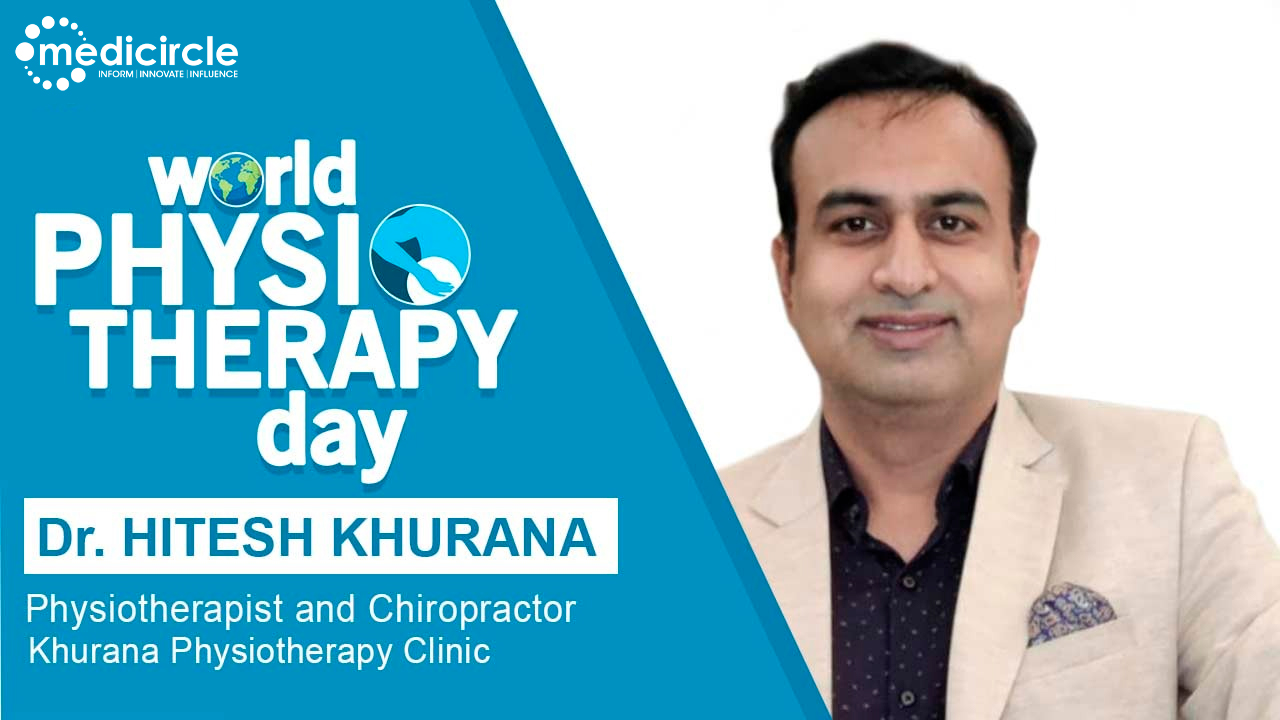Physical therapy helps individuals recover from an injury and develop, maintain, and restore maximum movement of the body and physical function. Physical therapy can also deal with a chronic condition and prevent future injury. World Physiotherapy Day was started on September 8 in 1996. The day founded in 1951 marks the solidarity of the global physiotherapy community.
The theme of this year is Long COVID and physiotherapy. This theme will focus on rehabilitation and long COVID and the role of physiotherapists in the treatment and management of people affected by Long COVID. We at Medicircle are conducting the World Physiotherapy day Awareness Series to raise awareness about the importance of physiotherapy and the role physiotherapists play in keeping people fit and well.
Dr. Hitesh Khurana is a physiotherapist and chiropractor practicing in his clinic - Khurana physiotherapy clinic for the last 15 years. In the last 15 years, they have treated more than 10,000 cases of various ailments and now they are one of the industry leaders in their proximity. They have expertise in Physiotherapy specialties like back neck and spine, back shoulder and knee and are also pioneer in sports injury cases.
All about physiotherapy
Dr. Hitesh expresses, “Physiotherapy is the branch of medicine, that uses physical agents or exercises to treat a disease or an injury. It could be pain management, psychological stress, physiological problem, etc. It is also called physical therapy. In physiotherapy, we use manual techniques to - reduce pain, restorative functions, and movements, normal lifestyle functioning, promoting mental health.
Dr. Hitesh says, “Physiotherapy is also known as healing hands as it uses hands and some special techniques to treat patients. We also use some kind of machinery, exercises, and corrective methods to treat patients. It can be used to treat pain, postural problems, and biomechanical changes. For this, first, we assess the patient, check postures, tenderness or pain and then we design effective treatment which is delivered in several ways. This is a highly efficient process where a lot of creativity is involved. We also add a lot of new things to the gradual healing process. This branch is growing as new advancements have been made in recent times through technologies and effective interventions. The physiotherapist becomes like a family as the doctor spends a lot of time in daily sessions with their patients. The role of physiotherapy exercises is much more than that of medicines. We tell them all dos, don’ts, and precautionary measures too.”
Myths about physiotherapy
Dr. Hitesh emphasizes, “Physiotherapy is a very vast field. We get to see patients of 6 months to 80 years. Physiotherapy is very creative or innovative. Physiotherapy is a wide-ranging profession with opportunities to work in many different areas including
Pregnancy – Antenatal and prenatal exercises
Sports – to relieve pain
Cardiovascular health – Rehabilitate cardiovascular strength
Post-surgery – any type of surgery
Orthopedics - Musculoskeletal outpatients, knee replacement, hip replacement
Pediatrics
Neurological physiotherapy – spinal cord injuries
Post cancer
Dr. Hitesh stresses, “Physiotherapy is painful, is a total myth. Only in 1-2% of cases, we have to treat with pain (by giving pain) For example in frozen shoulders, we try to increase the range by opening the capsule, so sometimes it is slightly painful. But physiotherapy is always at the limit of pain. We never try to give beyond what they can’t bear. In some cases, the pain intensifies in the beginning and then subsides gradually as the treatment progresses.”
Physiotherapy in long COVID
Dr. Hitesh mentions, “Physiotherapy helped a lot in post COVID rehabilitation.
Physiotherapy is useful in cardiovascular pumping, breathing issues, and maintaining saturation. Some techniques of physiotherapy are used to loosen the accumulated mucus in the chest like percussion, vibration, beating, bonding. Postural drainage is very useful. This helps in coughing out sputum, thereby improving breathing patterns. Thus, the patient feels comfortable. Many antibiotics and steroids doses get reduced while taking physio sessions. Patients come out from the critical zone and later recover fully. There are exercises for weakness or fatigue due to hospitalization. Breathing exercises strengthen the body. Respiratory improvement exercises, resistance training can also be given for post-COVID patients. PEP devices, thoracic extension, spirometry, and other customized exercises for individuals were also used in long COVID.”
(Edited by Renu Gupta)

 Dr. Hitesh Khurana gave an overview of physiotherapy and its opportunities in various fields. Dr. Hitesh also illustrated the role of physiotherapy in long COVID and busted some myths
Dr. Hitesh Khurana gave an overview of physiotherapy and its opportunities in various fields. Dr. Hitesh also illustrated the role of physiotherapy in long COVID and busted some myths










.jpeg)











.jpg)








